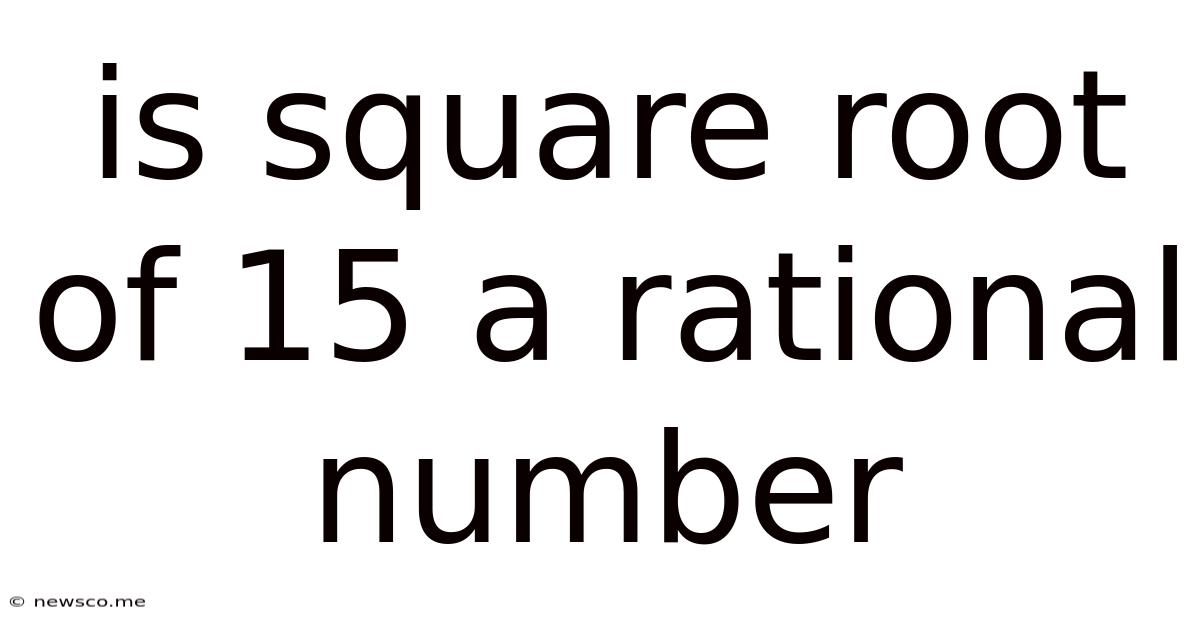Is Square Root Of 15 A Rational Number
News Co
May 08, 2025 · 5 min read

Table of Contents
Is the Square Root of 15 a Rational Number? A Deep Dive into Irrationality
The question of whether the square root of 15 is a rational number is a fundamental concept in mathematics, touching upon the core principles of number theory. Understanding this requires a grasp of rational and irrational numbers, and the methods for proving the irrationality of a number. This article will delve into this topic, providing a comprehensive explanation suitable for both beginners and those seeking a deeper understanding.
Understanding Rational and Irrational Numbers
Before tackling the square root of 15, let's establish a clear understanding of rational and irrational numbers.
Rational Numbers: These numbers can be expressed as a fraction p/q, where p and q are integers, and q is not zero. Examples include 1/2, 3/4, -2/5, and even integers like 4 (which can be expressed as 4/1). The decimal representation of a rational number either terminates (e.g., 0.75) or repeats infinitely with a repeating pattern (e.g., 0.333...).
Irrational Numbers: These numbers cannot be expressed as a fraction of two integers. Their decimal representations are non-terminating and non-repeating. Famous examples include π (pi) and e (Euler's number). The square root of most integers is also irrational, unless the integer is a perfect square (e.g., √9 = 3, which is rational).
Proof by Contradiction: The Standard Approach
The most common and elegant way to prove that √15 is irrational is using proof by contradiction. This method assumes the opposite of what we want to prove and then demonstrates that this assumption leads to a logical contradiction. Let's walk through this process:
Step 1: The Assumption
Let's assume that √15 is rational. This means we can express it as a fraction:
√15 = p/q
where p and q are integers, q ≠ 0, and p/q is in its simplest form (meaning p and q have no common factors other than 1; the fraction is reduced to its lowest terms).
Step 2: Squaring Both Sides
Squaring both sides of the equation, we get:
15 = p²/q²
Step 3: Rearranging the Equation
Rearranging the equation, we have:
15q² = p²
This equation tells us that p² is a multiple of 15. Since 15 = 3 x 5, this implies that p² is divisible by both 3 and 5. If p² is divisible by a prime number, then p itself must also be divisible by that prime number. Therefore, p must be divisible by both 3 and 5. We can express this as:
p = 3 * 5 * k = 15k
where k is an integer.
Step 4: Substitution and Simplification
Substituting p = 15k back into the equation 15q² = p², we get:
15q² = (15k)²
15q² = 225k²
Dividing both sides by 15:
q² = 15k²
This equation shows that q² is also a multiple of 15, and therefore q is also divisible by 15.
Step 5: The Contradiction
We've now shown that both p and q are divisible by 15. This contradicts our initial assumption that p/q is in its simplest form (reduced to its lowest terms). If both p and q are divisible by 15, they share a common factor greater than 1. This is a contradiction!
Step 6: The Conclusion
Because our initial assumption leads to a contradiction, the assumption must be false. Therefore, our original assumption that √15 is rational is incorrect.
Conclusion: √15 is irrational.
Exploring Further: Other Irrational Square Roots
The method used above to prove the irrationality of √15 can be generalized to prove the irrationality of the square root of any integer that is not a perfect square. For example, you could use the same process to show that √2, √3, √7, √10, etc., are all irrational. The key is always to find a prime factor that appears in the number under the square root but an uneven number of times in the prime factorization, leading to a contradiction when assuming rationality.
The Importance of Understanding Irrational Numbers
Understanding the distinction between rational and irrational numbers is crucial for several reasons:
-
Foundation of Real Numbers: Rational and irrational numbers together form the set of real numbers, the foundation of much of mathematics and its applications.
-
Calculus and Analysis: Irrational numbers play a vital role in calculus and real analysis, where concepts like limits and continuity rely on the properties of real numbers.
-
Geometry and Trigonometry: Many geometric and trigonometric calculations involve irrational numbers, such as π (pi) and the square root of various numbers.
Practical Applications and Real-World Examples
While irrational numbers might seem abstract, they have many practical applications:
-
Engineering and Physics: Calculations involving distances, areas, and volumes often lead to irrational numbers.
-
Computer Graphics and Modeling: Generating smooth curves and surfaces in computer graphics and 3D modeling often requires dealing with irrational numbers.
-
Financial Modeling: Certain financial calculations may involve irrational numbers, particularly when dealing with continuous growth or decay.
Conclusion: A Cornerstone of Mathematical Understanding
The proof that √15 is irrational is a beautiful illustration of the power of mathematical reasoning and the elegance of proof by contradiction. This concept, while seemingly simple, is a cornerstone of our understanding of numbers and forms a crucial foundation for more advanced mathematical concepts. Understanding irrational numbers and their properties is essential for anyone seeking a deeper understanding of mathematics and its widespread applications in various fields. It's a testament to the richness and intricacy hidden within even seemingly straightforward mathematical questions.
Latest Posts
Related Post
Thank you for visiting our website which covers about Is Square Root Of 15 A Rational Number . We hope the information provided has been useful to you. Feel free to contact us if you have any questions or need further assistance. See you next time and don't miss to bookmark.